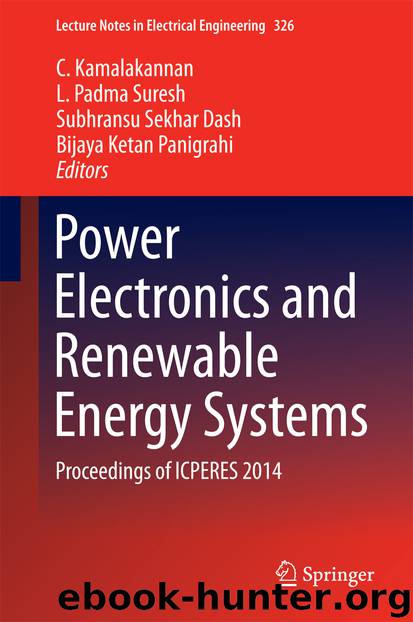Power Electronics and Renewable Energy Systems by C. Kamalakannan L. Padma Suresh Subhransu Sekhar Dash & Bijaya Ketan Panigrahi

Author:C. Kamalakannan, L. Padma Suresh, Subhransu Sekhar Dash & Bijaya Ketan Panigrahi
Language: eng
Format: epub
Publisher: Springer India, New Delhi
81.3.2 Solar Module
Solar modules use light energy (photons) from the sun to generate electricity through the photovoltaic effect. The structural (load carrying) member of a module can either be the top layer or the back layer. Cells must be protected from mechanical damage and moisture. Most solar modules are rigid, but semi-flexible ones are available, based on thin-film cells. These early solar modules were first used in space in 1958. Electrical connections are made in series to achieve a desired output voltage and/or in parallel to provide a desired current capability [2]. The requirements for residential and commercial are different in that the residential needs are simple and can be packaged so that as solar cell technology progresses, the other base line equipment such as the battery, inverter and voltage sensing transfer switch still need to be compacted and unitized for residential use (Fig. 81.5).
Fig. 81.5Schematic approach of proposed system
Download
This site does not store any files on its server. We only index and link to content provided by other sites. Please contact the content providers to delete copyright contents if any and email us, we'll remove relevant links or contents immediately.
| Automotive | Engineering |
| Transportation |
Whiskies Galore by Ian Buxton(41533)
Introduction to Aircraft Design (Cambridge Aerospace Series) by John P. Fielding(32890)
Small Unmanned Fixed-wing Aircraft Design by Andrew J. Keane Andras Sobester James P. Scanlan & András Sóbester & James P. Scanlan(32574)
Craft Beer for the Homebrewer by Michael Agnew(17935)
Turbulence by E. J. Noyes(7702)
The Complete Stick Figure Physics Tutorials by Allen Sarah(7143)
Kaplan MCAT General Chemistry Review by Kaplan(6597)
The Thirst by Nesbo Jo(6439)
Bad Blood by John Carreyrou(6278)
Modelling of Convective Heat and Mass Transfer in Rotating Flows by Igor V. Shevchuk(6225)
Learning SQL by Alan Beaulieu(6037)
Weapons of Math Destruction by Cathy O'Neil(5832)
Man-made Catastrophes and Risk Information Concealment by Dmitry Chernov & Didier Sornette(5650)
Digital Minimalism by Cal Newport;(5392)
Life 3.0: Being Human in the Age of Artificial Intelligence by Tegmark Max(5189)
iGen by Jean M. Twenge(5163)
Secrets of Antigravity Propulsion: Tesla, UFOs, and Classified Aerospace Technology by Ph.D. Paul A. Laviolette(4995)
Design of Trajectory Optimization Approach for Space Maneuver Vehicle Skip Entry Problems by Runqi Chai & Al Savvaris & Antonios Tsourdos & Senchun Chai(4843)
Electronic Devices & Circuits by Jacob Millman & Christos C. Halkias(4750)
